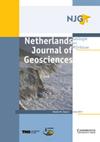荷兰瓦登海沉积物收支和形态发展:2100年前海平面加速上升和下沉的影响
IF 2.3
2区 地球科学
Q3 GEOSCIENCES, MULTIDISCIPLINARY
Netherlands Journal of Geosciences-Geologie En Mijnbouw
Pub Date : 2018-09-01
DOI:10.1017/njg.2018.8
引用次数: 54
摘要
瓦登海是一个独特的沿海湿地,包含一个不间断的潮滩,沿着北海海岸从荷兰到丹麦跨越近500公里的距离。该系统的发展面临着气候变化的压力,特别是与之相关的海平面上升加速。该系统的可持续管理,以确保对腹地洪水的安全,保护环境价值,并优化该地区的经济活动,需要对未来形态发展进行预测。荷兰瓦登海一直在通过从潮退三角洲和屏障岛的北海海岸进口沉积物而增加。自1926年以来的平均吸积率一直高于当地的相对单反。大量沉积物的进口主要是由祖得泽河和劳沃泽河筑坝造成的,而不是由于海平面上升造成的。各潮盆的潮间带高度增加以补偿单反效应。堰洲岛、退潮三角洲和潮汐盆地组成了潮汐通道和滩涂,共同形成了一个沉积物共享系统。潮口与潮盆间的残沙输运受到不同过程和机制的影响。在荷兰瓦登海,残余流、潮汐不对称和分散是主要的。潮汐通道和潮滩的相互作用受潮汐和波浪的共同作用。潮滩的高度是潮汐供给沙和海浪再悬浮沙之间平衡的结果。目前,用于评估加速单反效应的长期模型主要依赖于聚合模型。这些模型被用来评估荷兰瓦登海潮汐盆地沉积物输入的最大速率。为了探索荷兰瓦登海的未来状态,将这些最大速率与SLR和开采引起的沉降相比较。在不久的将来,到2030年,单反加速的影响将是有限的,几乎不明显。从长期来看,到2100年,影响取决于单反情景。根据低端情景,单反在2100年之前几乎不会产生任何影响,而根据高端情景,这种影响在2050年就已经明显了。本文章由计算机程序翻译,如有差异,请以英文原文为准。
Sediment budget and morphological development of the Dutch Wadden Sea: impact of accelerated sea-level rise and subsidence until 2100
Abstract The Wadden Sea is a unique coastal wetland containing an uninterrupted stretch of tidal flats that span a distance of nearly 500km along the North Sea coast from the Netherlands to Denmark. The development of this system is under pressure of climate change and especially the associated acceleration in sea-level rise (SLR). Sustainable management of the system to ensure safety against flooding of the hinterland, to protect the environmental value and to optimise the economic activities in the area requires predictions of the future morphological development. The Dutch Wadden Sea has been accreting by importing sediment from the ebb-tidal deltas and the North Sea coasts of the barrier islands. The average accretion rate since 1926 has been higher than that of the local relative SLR. The large sediment imports are predominantly caused by the damming of the Zuiderzee and Lauwerszee rather than due to response to this rise in sea level. The intertidal flats in all tidal basins increased in height to compensate for SLR. The barrier islands, the ebb-tidal deltas and the tidal basins that comprise tidal channels and flats together form a sediment-sharing system. The residual sediment transport between a tidal basin and its ebb-tidal delta through the tidal inlet is influenced by different processes and mechanisms. In the Dutch Wadden Sea, residual flow, tidal asymmetry and dispersion are dominant. The interaction between tidal channels and tidal flats is governed by both tides and waves. The height of the tidal flats is the result of the balance between sand supply by the tide and resuspension by waves. At present, long-term modelling for evaluating the effects of accelerated SLR mainly relies on aggregated models. These models are used to evaluate the maximum rates of sediment import into the tidal basins in the Dutch Wadden Sea. These maximum rates are compared to the combined scenarios of SLR and extraction-induced subsidence, in order to explore the future state of the Dutch Wadden Sea. For the near future, up to 2030, the effect of accelerated SLR will be limited and hardly noticeable. Over the long term, by the year 2100, the effect depends on the SLR scenarios. According to the low-end scenario, there will be hardly any effect due to SLR until 2100, whereas according to the high-end scenario the effect will be noticeable already in 2050.
求助全文
通过发布文献求助,成功后即可免费获取论文全文。
去求助
来源期刊
CiteScore
4.00
自引率
25.90%
发文量
14
审稿时长
>12 weeks
期刊介绍:
Netherlands Journal of Geosciences - Geologie en Mijnbouw is a fully open access journal which publishes papers on all aspects of geoscience, providing they are of international interest and quality. As the official publication of the ''Netherlands Journal of Geosciences'' Foundation the journal publishes new and significant research in geosciences with a regional focus on the Netherlands, the North Sea region and relevant adjacent areas. A wide range of topics within the geosciences are covered in the journal, including "geology, physical geography, geophyics, (geo-)archeology, paleontology, hydro(geo)logy, hydrocarbon exploration, modelling and visualisation."
The journal is a continuation of Geologie and Mijnbouw (published by the Royal Geological and Mining Society of the Netherlands, KNGMG) and Mededelingen Nederlands Instituut voor Toegepaste Geowetenschappen (published by TNO Geological Survey of the Netherlands). The journal is published in full colour.

 求助内容:
求助内容: 应助结果提醒方式:
应助结果提醒方式:


